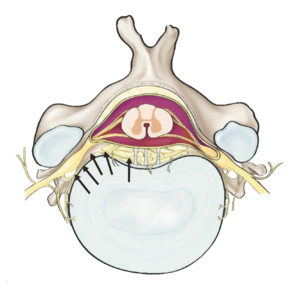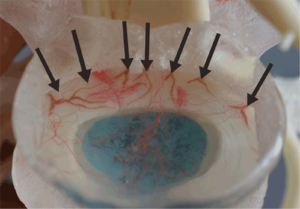Sinuvertebral Nerve: Difference between revisions
(Created page with "== Description == '''The sinuvertebral nerve''' (or '''Luschka nerve''') is a recurrent nerve that originates from the ventral ramus, re-entering the spinal canal via the inte...") |
Kim Jackson (talk | contribs) m (Kim Jackson moved page Sinuvertebral nerve to Sinuvertebral Nerve: Capitilise Title) |
||
| (12 intermediate revisions by one other user not shown) | |||
| Line 1: | Line 1: | ||
<div class="editorbox"> | |||
'''Original Editor '''- [[User:Denys Nahornyi|Denys Nahornyi]] | |||
'''Top Contributors''' - [[User:Denys Nahornyi|Denys Nahornyi]] | |||
</div> | |||
== Description == | == Description == | ||
'''The sinuvertebral nerve''' (or '''Luschka nerve''') is a recurrent nerve that originates from the ventral ramus | [[File:Sinuvertebral nerve2.png|thumb|Sinuvertebral nerve (arrows) taking a recurrent course and reenters the spinal canal through the intervertebral foramen.]] | ||
'''The sinuvertebral nerve''' (or '''Luschka nerve''') is a recurrent nerve that originates from the ventral ramus rande-entering the spinal canal via the intervertebral foramina to innervate the [[Intervertebral disc|anulus fibrosus of the intervertebral disc]], the ligaments and periosteum of the spinal canal. Its complex anatomy and relationship to discogenic pain have warranted great interest among clinical anatomists owing to its sympathetic contribution to the lumbar spine. Knowledge of the nerve has been used to design a variety of diagnostic and treatment procedures for chronic [[Lumbar Discogenic Pain|discogenic pain]] <ref name=":0">Shayota B, Wong TL, Fru D, David G, Iwanaga G, Loukas M. [https://www.ncbi.nlm.nih.gov/pmc/articles/PMC6624329/ A comprehensive review of the sinuvertebral nerve with clinical applications]. ''Anat Cell Biol''. 2019;52(2):128-133.</ref>. | |||
=== Root === | |||
Spinal nerve. | |||
=== Branches === | |||
Sinuvertebral nerve originates from the ventral ramus of spinal nerves. | |||
== Function == | |||
Innervate multiple meningeal and non-meningeal structures. Is a somatic and vegetative nerve. | |||
=== Motor === | |||
Absent. | |||
=== Sensory === | |||
* [[Intervertebral disc|Anulus fibrosus of the intervertebral disc]]; | |||
* Ligaments and periosteum of the spinal canal; | |||
* Anterior portion of the dura mater. | |||
== | == Clinical relevance == | ||
[[File:Sinuvertebral | [[File:Sinuvertebral nerve3.png|thumb|The synvertebral nerve (red arrows) may grow deep into the disc]] | ||
Associated with the discogenic type low back pain (pain from an injured vertebral disc), accounts for approximately 26%–39% of patients with [[Low Back Pain|low back pain]] <ref>Manchikanti L, Singh V, Pampati V, Damron KS, Barnhill RC, Beyer C, Cash KA. [https://www.painphysicianjournal.com/linkout?issn=1533-3159&vol=4&page=308 Evaluation of the relative contributions of various structures in chronic low back pain.] Pain Physician. 2001;4:308–316.</ref>. | |||
Although the sinuvertebral nerve fibers are said to terminate in the outer anulus, it is now widely accepted that this end point is not permanent. Studies of healthy patients normally show neural penetration of the anulus at about 3 mm <ref>Ashton IK, Walsh DA, Polak JM, Eisenstein SM. [https://www.tandfonline.com/doi/abs/10.3109/17453679408994620 Substance P in intervertebral discs: binding sites on vascular endothelium of the human annulus fibrosus]. Acta Orthop Scand. 1994;65:635–639.</ref>, corresponding to the three outer lamellae. However, degenerative discs have shown penetration of nerve fibers as far as the inner one third in one study <ref>McCarthy PW, Carruthers B, Martin D, Petts P, Films DC. [https://journals.lww.com/spinejournal/Abstract/1991/06000/Immunohistochemical_Demonstration_of_Sensory_Nerve.10.aspx Immunohistochemical Demonstration of Sensory Nerve Fibers and Endings in Lumbar Intervertebral Discs of the Rat]. Spine.1991;16:653-655.</ref>, and into the nucleus pulposus in another <ref>Peng B, Wu W, Hou S, Li P, Zhang C, Yang Y. [https://pubmed.ncbi.nlm.nih.gov/15686239/ The pathogenesis of discogenic low back pain]. ''J Bone Joint Surg Br''. 2005;87(1):62-67.</ref>. | |||
== | == Assessment == | ||
Provocative discography (has proved significantly more effective for diagnosing degenerative disc disease than magnetic resonance imaging) <ref>Choi SH, Adsul N, Kim HS, Jang JS, Jang IT, Oh SH. [https://www.sciencedirect.com/science/article/abs/pii/S1878875017320831?via%3Dihub Magnetic resonance imaging undetectable epiduroscopic hotspot in chronic diskogenic back pain: does sinuvertebral neuropathy actually exist?] World Neurosurg. 2018;110:354–358</ref>. | |||
== | == See also == | ||
[[ | * [[Disc Herniation]] | ||
* [[Degenerative Disc Disease]] | |||
* [[Low Back Pain]] | |||
== References == | |||
<references /> | |||
[[Category:Anatomy]] | |||
[[Category:Nerves]] | |||
Latest revision as of 00:40, 23 October 2020
Original Editor - Denys Nahornyi
Top Contributors - Denys Nahornyi
Description[edit | edit source]
The sinuvertebral nerve (or Luschka nerve) is a recurrent nerve that originates from the ventral ramus rande-entering the spinal canal via the intervertebral foramina to innervate the anulus fibrosus of the intervertebral disc, the ligaments and periosteum of the spinal canal. Its complex anatomy and relationship to discogenic pain have warranted great interest among clinical anatomists owing to its sympathetic contribution to the lumbar spine. Knowledge of the nerve has been used to design a variety of diagnostic and treatment procedures for chronic discogenic pain [1].
Root[edit | edit source]
Spinal nerve.
Branches[edit | edit source]
Sinuvertebral nerve originates from the ventral ramus of spinal nerves.
Function[edit | edit source]
Innervate multiple meningeal and non-meningeal structures. Is a somatic and vegetative nerve.
Motor[edit | edit source]
Absent.
Sensory[edit | edit source]
- Anulus fibrosus of the intervertebral disc;
- Ligaments and periosteum of the spinal canal;
- Anterior portion of the dura mater.
Clinical relevance[edit | edit source]
Associated with the discogenic type low back pain (pain from an injured vertebral disc), accounts for approximately 26%–39% of patients with low back pain [2].
Although the sinuvertebral nerve fibers are said to terminate in the outer anulus, it is now widely accepted that this end point is not permanent. Studies of healthy patients normally show neural penetration of the anulus at about 3 mm [3], corresponding to the three outer lamellae. However, degenerative discs have shown penetration of nerve fibers as far as the inner one third in one study [4], and into the nucleus pulposus in another [5].
Assessment[edit | edit source]
Provocative discography (has proved significantly more effective for diagnosing degenerative disc disease than magnetic resonance imaging) [6].
See also[edit | edit source]
References[edit | edit source]
- ↑ Shayota B, Wong TL, Fru D, David G, Iwanaga G, Loukas M. A comprehensive review of the sinuvertebral nerve with clinical applications. Anat Cell Biol. 2019;52(2):128-133.
- ↑ Manchikanti L, Singh V, Pampati V, Damron KS, Barnhill RC, Beyer C, Cash KA. Evaluation of the relative contributions of various structures in chronic low back pain. Pain Physician. 2001;4:308–316.
- ↑ Ashton IK, Walsh DA, Polak JM, Eisenstein SM. Substance P in intervertebral discs: binding sites on vascular endothelium of the human annulus fibrosus. Acta Orthop Scand. 1994;65:635–639.
- ↑ McCarthy PW, Carruthers B, Martin D, Petts P, Films DC. Immunohistochemical Demonstration of Sensory Nerve Fibers and Endings in Lumbar Intervertebral Discs of the Rat. Spine.1991;16:653-655.
- ↑ Peng B, Wu W, Hou S, Li P, Zhang C, Yang Y. The pathogenesis of discogenic low back pain. J Bone Joint Surg Br. 2005;87(1):62-67.
- ↑ Choi SH, Adsul N, Kim HS, Jang JS, Jang IT, Oh SH. Magnetic resonance imaging undetectable epiduroscopic hotspot in chronic diskogenic back pain: does sinuvertebral neuropathy actually exist? World Neurosurg. 2018;110:354–358








